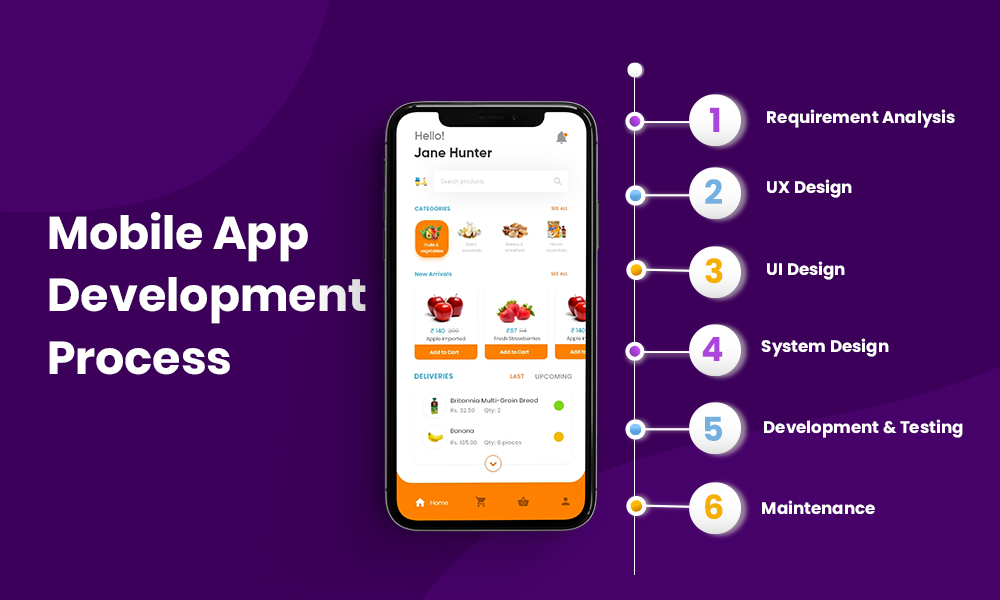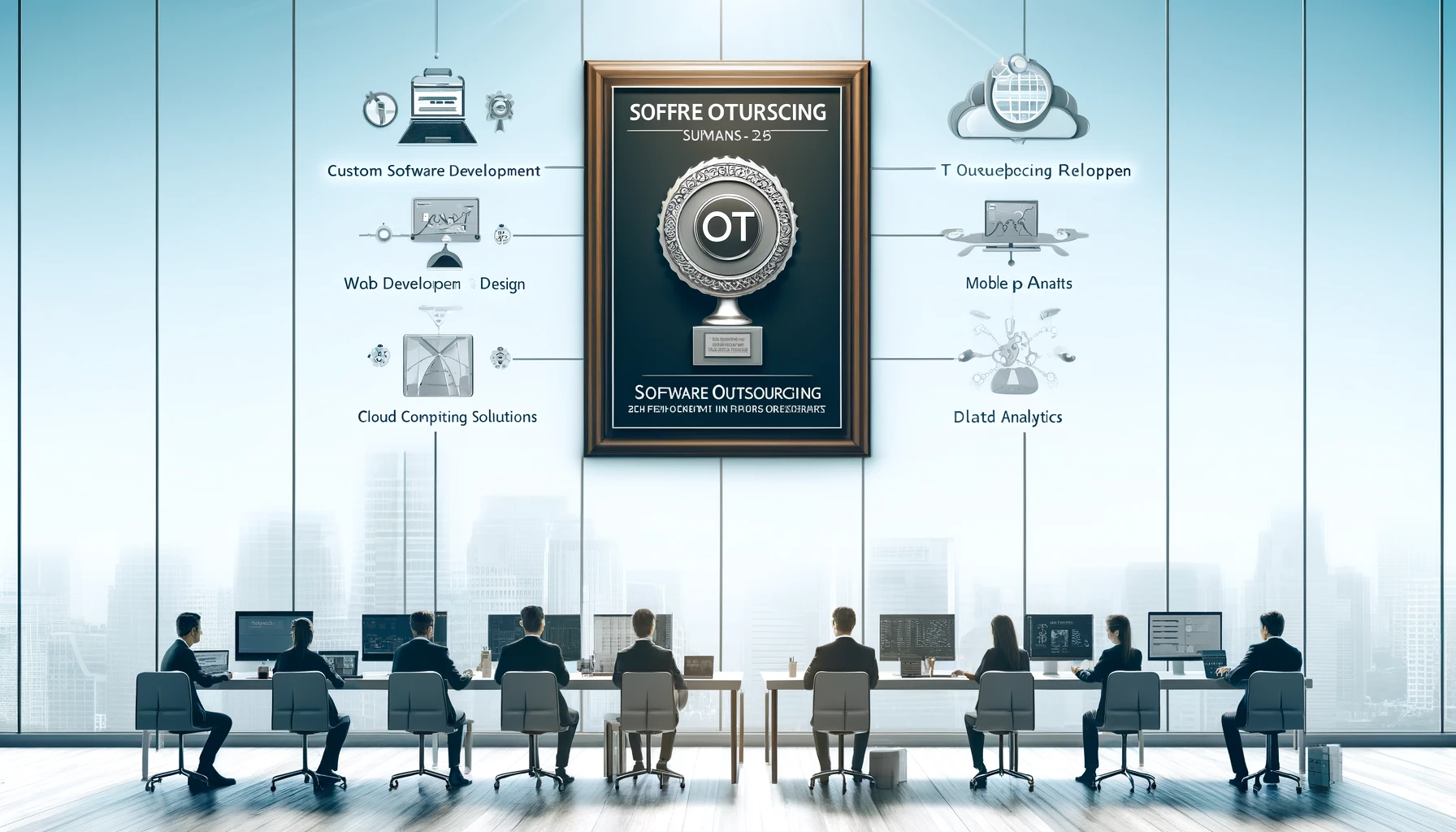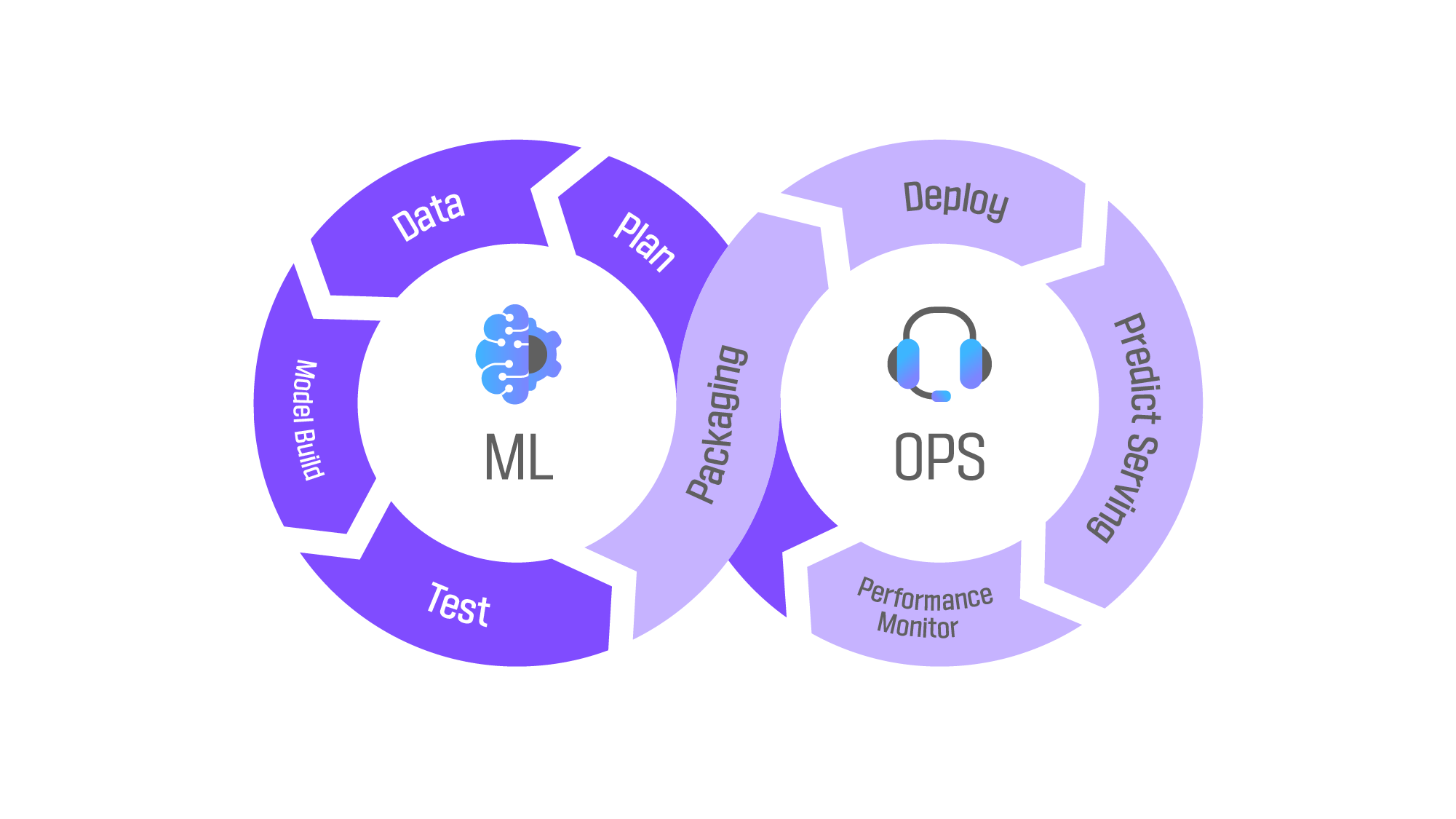The proliferation of mobile applications in the market continues to surge, with an increasing number of releases each day. Furthermore, the number of mobile devices globally has surpassed the world’s population. Consequently, it is not surprising that by 2026, mobile applications are estimated to generate a remarkable revenue of $233 billion. Given such promising projections, numerous companies are keen on exploring mobile app development opportunities. Some companies prioritize consumer-facing projects, aiming to generate revenue, whereas others opt for enterprise solutions that streamline internal processes and boost operational efficiency.
If your organization is interested in developing a mobile app, it is crucial to understand the app development process. In this regard, we will provide a comprehensive mobile app creation guide based on our experience to help you get started.
Strategy Development
The initial and crucial step in the app development process is defining the strategy, which involves carefully contemplating your app’s objectives, capabilities, and business model. Regardless of whether you are creating a consumer or enterprise app, identifying its primary objectives is essential. To accomplish this, it is necessary to answer critical questions such as the problem the app aims to solve, the target users, and the desired results. Although you may already have an idea for your app, outlining its key objectives will help you stay focused on your goals.
Additionally, researching existing or potential competitors is an integral aspect of strategy planning. Understanding the landscape of similar mobile apps and avoiding mistakes made by others within your industry will help you differentiate your app from the competition. Furthermore, selecting the appropriate platform for your app is vital, whether it is a custom Android solution, an iOS app, or a cross-platform application.
For consumer applications, selecting the appropriate monetization method is also crucial. Depending on your goals and the type of app you are developing, several options are available, including in-app advertising, in-app purchases, subscriptions, affiliate marketing, and paid apps. For instance, a dating app may leverage in-app purchases and subscriptions, while a game app may use in-app advertising and subscriptions. It is worth noting that the subscription-based monetization model is increasingly gaining popularity.
Analysis and Planning
The second step in the app development process involves analysis and planning. At this stage, you should have a clear idea of your app’s purpose, conducted thorough research, and identified a general direction for development. Now is the time to focus on the details to ensure successful design and development.
To begin, you need to define the functional and non-functional requirements for your app. This involves outlining specific actions that your app must perform, such as managing credit cards or generating account statements. Non-functional requirements relate to the quality of your app’s performance and its impact on the user experience.
The next step is to create a product roadmap, outlining a detailed plan for reaching your end goals. You’ll need to identify all of the features you want your app to have and prioritize them, considering which can be added later.
Finally, you must identify the technology stack required for your project. This includes determining which skills and technologies are needed, such as experienced iOS developers for an iOS app or technologies like Titanium and Xamarin for cross-platform development. It is important to have the technology stack aspect of your project determined before moving forward.
UI/UX Design
To ensure optimal user experience, meticulous attention must be given to an app’s design. A cluttered or flawed design can drive users towards competitors, thereby jeopardizing the success of your app. Therefore, it is imperative that your UI/UX design be intuitive, user-friendly, engaging, and provide a seamless experience. In this regard, let us delve into each design area in detail.
Information architecture and workflows are the primary components of the app design process. At this stage, you must define the data to be incorporated in your app, its display, and how users will interact with it. Subsequently, you can create workflow diagrams that help keep track of all user interactions and facilitate easy navigation.
Business analysts create wireframes, which are digital sketches outlining the conceptual layout and visual structure of the app’s functionality. Wireframes prioritize user experience and app aesthetics to ensure that the final product is easy to use and visually appealing.
Style guides are essential to maintain consistency in your app’s design and branding. They provide instructions for fonts, color scheme, spacing, positioning, buttons, widgets, and other design elements, all in a single document.
Mockups are final visual renderings of your app that apply the style guide to the wireframes, ensuring design consistency throughout the app.
Lastly, the UI/UX design process culminates in developing prototypes that simulate the app’s workflow and user experience. This stage is critical to detecting any design or functionality mishaps that may need to be fixed before launch. Despite being time-consuming, prototypes are an essential step in the design process.
App Development
Upon completion of the design phase, the next critical stage of the mobile app development process is the creation of the backend and frontend. The backend stage involves the development of databases and server-side objects responsible for the app’s performance. At this point, the development team selects appropriate programming languages, codes the app, and chooses database engines and a hosting environment. The scalability of the app in the future depends heavily on the backend stage, making it a crucial aspect of the app development life cycle. Engaging experienced software developers can help ensure that your system can scale effortlessly as your user base grows. On the other hand, the frontend is what the end-user will primarily interact with, and there are three approaches to building it: platform-specific, cross-platform, and hybrid. Each approach has its advantages and is selected based on the project’s specific requirements.
Mobile App Testing
After completing the app development phase, it is crucial to conduct thorough testing to ensure the developed solution is stable, secure, and free of bugs.
To deliver the highest quality, the app should undergo five testing methods prior to deployment.
Functionality testing checks the application’s features to ensure everything functions properly. Performance testing assesses the app’s responsiveness and its ability to handle an increase in concurrent users.
In addition to functionality and performance testing, data protection is essential for enterprise solutions like mobile insurance and healthcare applications, while consumer apps must adhere to all security standards and remain loophole-free.
Platform and device compatibility testing is also important to ensure that the app functions optimally on various devices and operating systems.
Finally, an extended review involving focus groups or a beta launch allows the app to be tested by actual users to gather feedback and improve the overall user experience before deployment.
Deployment
When it comes time to deploy your mobile app, different distribution models are available depending on the platform you developed for.
The mobile application deployment strategy is relatively straightforward. You will need to either submit your app to Apple’s App Store or Google’s Play Store, or pursue private distribution.
Both stores require the completion of several forms and the submission of your app for review. It’s worth noting that the App Store is known to be more rigorous in its selection of apps. Therefore, if your iOS-based tool does not meet high standards, you may encounter difficulties.
Alternatively, if you choose private distribution, consider exploring Apple’s Developer Enterprise Program or Android’s Alternative Distributions to determine the best course of action.
Support and Performance Monitoring
After deploying your mobile app and observing consistent downloads by users, it is crucial to analyze its performance by monitoring key performance indicators (KPIs). Some of the significant KPIs include the number of downloads, active users, average visit duration, retention, churn, conversions, customer lifetime value, ratings, and reviews. It is equally important to keep track of crashes, bugs, customer requests, and overall app performance to refine your solution over time. It is vital to note that the work of maintaining your mobile app does not end with deployment, and regular updates are necessary to keep up with evolving operating systems, review guidelines, and performance standards. This way, your investment in the app remains valuable. You may choose to manage the maintenance yourself or partner with a software development company for post-launch support services, taking the upkeep work off your hands.
Key Considerations Before Starting the App Development Process
Before embarking on a software development journey, it’s crucial to consider a few points. Firstly, consider if creating a mobile app is a strategic priority for your business. Developing a mobile application can be a costly endeavor, and it’s important to determine if it aligns with your digital strategy. Secondly, think about the implications of developing enterprise versus consumer-facing apps. The strategic questions will differ based on the end-users. If building an app for the world to try, you must ensure the uniqueness of your solution and its commercial purpose. On the other hand, if your employees are the end-users, their preferences and opinions should be considered. Lastly, determine whether to build your mobile app in-house or outsource to a development partner. The decision will depend on the availability of an experienced IT team within your organization and the ability to take on a mobile app project. If there are no available developers, outsourcing may be a suitable option to build a unique application for your business.





4 Comments
Your comment is awaiting moderation.
This site definitely has all of the information I needed about this subject
My website: anilingus.tv
Your comment is awaiting moderation.
best price doxycycline uk: doxycycline over the counter singapore – doxycycline buy online usa
Your comment is awaiting moderation.
paxlovid price: paxlovid pharmacy – paxlovid india
Your comment is awaiting moderation.
http://amoxildelivery.pro/# amoxicillin online pharmacy
Your comment is awaiting moderation.
cipro ciprofloxacin: buy cipro online usa – buy cipro without rx
Your comment is awaiting moderation.
https://ciprodelivery.pro/# cipro online no prescription in the usa
doxycycline 100 mg cap over the counter doxycycline 100mg lowest price doxycycline pharmacy singapore
Your comment is awaiting moderation.
Right here is the right webpage for anyone who wants to find out about this topic. You know so much its almost hard to argue with you (not that I actually would want to…HaHa). You certainly put a fresh spin on a subject that’s been written about for many years. Great stuff, just great.
Your comment is awaiting moderation.
https://clomiddelivery.pro/# cheap clomid now
Your comment is awaiting moderation.
https://paxloviddelivery.pro/# paxlovid pill
ciprofloxacin generic buy cipro cheap cipro
Your comment is awaiting moderation.
doxycycline 100 mg cap: 100 doxycycline – doxycycline 100 mg cap
Your comment is awaiting moderation.
Spot on with this write-up, I honestly believe this website needs a lot more attention. I’ll probably be returning to read more, thanks for the information.
Your comment is awaiting moderation.
http://ciprodelivery.pro/# ciprofloxacin mail online
Your comment is awaiting moderation.
buy doxycycline 50 mg: doxycycline south africa – can you buy doxycycline over the counter uk
http://doxycyclinedelivery.pro/# doxycycline 300 mg price
cost of clomid no prescription where buy clomid for sale can i buy cheap clomid without prescription
Your comment is awaiting moderation.
http://ciprodelivery.pro/# п»їcipro generic
where buy clomid price can i get clomid online where to buy generic clomid no prescription
Your comment is awaiting moderation.
https://ciprodelivery.pro/# purchase cipro
Your comment is awaiting moderation.
amoxicillin 500mg price: can you buy amoxicillin over the counter canada – amoxicillin 500
Your comment is awaiting moderation.
amoxicillin brand name: can you purchase amoxicillin online – can you buy amoxicillin uk
https://amoxildelivery.pro/# amoxicillin 500 capsule
paxlovid cost without insurance paxlovid price paxlovid pill
Your comment is awaiting moderation.
https://ciprodelivery.pro/# buy ciprofloxacin
doxycycline tablet doxycycline 50mg tablets price doxycycline pharmacy uk
Your comment is awaiting moderation.
http://clomiddelivery.pro/# cost generic clomid without a prescription
Your comment is awaiting moderation.
can i buy cheap clomid for sale: can i purchase generic clomid pills – get generic clomid without prescription
http://ciprodelivery.pro/# antibiotics cipro
cipro 500mg best prices cipro for sale buy cipro cheap
Your comment is awaiting moderation.
https://ciprodelivery.pro/# buy cipro online
Your comment is awaiting moderation.
http://doxycyclinedelivery.pro/# doxycycline for dogs
Paxlovid over the counter Paxlovid buy online paxlovid for sale
Your comment is awaiting moderation.
amoxicillin 750 mg price: amoxicillin azithromycin – buy amoxicillin 500mg usa
Your comment is awaiting moderation.
I must thank you for the efforts you have put in penning this website. I really hope to check out the same high-grade blog posts from you later on as well. In truth, your creative writing abilities has encouraged me to get my very own site now 😉
Your comment is awaiting moderation.
When I originally left a comment I seem to have clicked the -Notify me when new comments are added- checkbox and now whenever a comment is added I get 4 emails with the exact same comment. There has to be a way you can remove me from that service? Kudos.
Your comment is awaiting moderation.
Nice post. I learn something new and challenging on sites I stumbleupon on a daily basis. It’s always interesting to read articles from other authors and practice a little something from other sites.
Your comment is awaiting moderation.
Hi! I could have sworn I’ve visited this website before but after looking at a few of the posts I realized it’s new to me. Anyhow, I’m certainly delighted I found it and I’ll be book-marking it and checking back frequently!
Your comment is awaiting moderation.
https://amoxildelivery.pro/# amoxicillin for sale
Your comment is awaiting moderation.
doxycycline 300 mg price: doxycycline 100 mg cost generic – buy doxycycline 200 mg
http://ciprodelivery.pro/# buy ciprofloxacin
cipro ciprofloxacin ciprofloxacin 500 mg tablet price buy cipro online
Your comment is awaiting moderation.
You ought to be a part of a contest for one of the finest blogs on the internet. I am going to highly recommend this website!
Your comment is awaiting moderation.
http://amoxildelivery.pro/# generic for amoxicillin
ciprofloxacin 500mg buy online buy cipro online buy cipro
Your comment is awaiting moderation.
where can i buy clomid without rx: how can i get clomid online – order cheap clomid without rx
Your comment is awaiting moderation.
Next time I read a blog, I hope that it does not fail me as much as this particular one. I mean, Yes, it was my choice to read through, however I actually thought you would probably have something useful to say. All I hear is a bunch of crying about something that you could fix if you were not too busy searching for attention.
Your comment is awaiting moderation.
http://clomiddelivery.pro/# clomid pill
Your comment is awaiting moderation.
paxlovid pill: п»їpaxlovid – paxlovid covid
https://ciprodelivery.pro/# cipro for sale
order doxycycline online canada where to get doxycycline where to buy doxycycline in singapore
Your comment is awaiting moderation.
http://paxloviddelivery.pro/# paxlovid price
can you buy amoxicillin over the counter canada amoxicillin 500mg order amoxicillin 500mg
Your comment is awaiting moderation.
http://ciprodelivery.pro/# cipro
Your comment is awaiting moderation.
where to buy clomid tablets: order clomid without dr prescription – cost of cheap clomid pill
Your comment is awaiting moderation.
canadian pharmacy 24: my canadian pharmacy review – pharmacy in canada
Your comment is awaiting moderation.
I was able to find good info from your blog articles.
Your comment is awaiting moderation.
mexican pharmaceuticals online: mexico drug stores pharmacies – buying prescription drugs in mexico
https://indiapharmast.com/# india online pharmacy
mexican pharmacy mexico pharmacy mexican online pharmacies prescription drugs
Your comment is awaiting moderation.
п»їlegitimate online pharmacies india: online shopping pharmacy india – top 10 online pharmacy in india
Your comment is awaiting moderation.
canadianpharmacy com escrow pharmacy canada global pharmacy canada
Your comment is awaiting moderation.
maple leaf pharmacy in canada: canadianpharmacyworld – canadian drugs online
Your comment is awaiting moderation.
http://foruspharma.com/# п»їbest mexican online pharmacies
Your comment is awaiting moderation.
pet meds without vet prescription canada: canadian pharmacy mall – canadian pharmacy king reviews
Your comment is awaiting moderation.
medication from mexico pharmacy mexican pharmacy mexican online pharmacies prescription drugs
Your comment is awaiting moderation.
canadian pharmacies: canadian pharmacy – real canadian pharmacy
Your comment is awaiting moderation.
http://indiapharmast.com/# best india pharmacy
Your comment is awaiting moderation.
india pharmacy mail order: reputable indian pharmacies – best india pharmacy
Your comment is awaiting moderation.
pharmacy website india: buy prescription drugs from india – best online pharmacy india
http://foruspharma.com/# buying prescription drugs in mexico
mexican mail order pharmacies medication from mexico pharmacy medication from mexico pharmacy
Your comment is awaiting moderation.
canada pharmacy onlinecanadianpharmacy 24 canadianpharmacymeds com
Your comment is awaiting moderation.
mexican drugstore online: mexico pharmacy – mexican online pharmacies prescription drugs
Your comment is awaiting moderation.
https://foruspharma.com/# pharmacies in mexico that ship to usa
Your comment is awaiting moderation.
mexico pharmacies prescription drugs
http://cmqpharma.com/# medication from mexico pharmacy
mexico drug stores pharmacies
Your comment is awaiting moderation.
mexico pharmacy: cmq pharma – mexican drugstore online
Your comment is awaiting moderation.
hello!,I love your writing very a lot! proportion we be in contact
extra about your article on AOL? I require an expert on this house to solve my
problem. May be that is you! Taking a look ahead to look you.
Your comment is awaiting moderation.
Very nice post and straight to the point. I don’t know
if this is actually the best place to ask but do you folks have any thoughts on where to employ some professional
writers? Thank you 🙂 Escape rooms hub
Your comment is awaiting moderation.
Thank you for your sharing. I am worried that I lack creative ideas. It is your article that makes me full of hope. Thank you. But, I have a question, can you help me?
I don’t think the title of your article matches the content lol. Just kidding, mainly because I had some doubts after reading the article. https://accounts.binance.com/de-CH/register?ref=S5H7X3LP
Thanks for paying attention to our blog. Our consultation is free so you can leave your questions here and we will try to answer them asap.
Thank you very much for sharing, I learned a lot from your article. Very cool. Thanks. nimabi
Thanks for paying attention to our blog. Our consultation is free so you can leave your questions here and we will try to answer them asap.